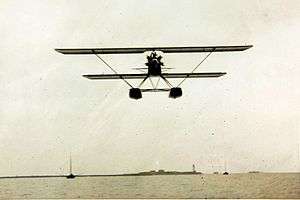Fokker C.VII-W
| C.VII-W | |
|---|---|
 | |
| Role | Reconnaissance aircraft |
| Manufacturer | Fokker |
| First flight | 1928 |
| Primary user | Royal Netherlands Navy |
| Number built | 30 |
|
| |
The Fokker C.VII-W was a reconnaissance seaplane built in the Netherlands in the late 1920s. Sharing elements of the highly successful C.V design, the C.VII-W was a conventional, single-bay biplane with wings of unequal span braced with N-struts. The undercarriage consisted of a standard twin-pontoon arrangement, and the fin and rudder continued through to the ventral side of the fuselage, creating a cruciform tail. The pilot and observer sat in tandem, open cockpits. The wing structure was wooden with fabric and plywood covering, and the fuselage was of steel tube construction with fabric covering.
The first twelve of the thirty examples produced were sent to the Dutch East Indies, with the rest remaining in the Netherlands. The type was withdrawn from front-line service in 1940, but some machines remained active in the East Indies as trainers until the Japanese invasion in 1942.
Operators
Specifications
General characteristics
- Crew: Two, pilot and observer
- Length: 9.50 m (31 ft 2 in)
- Wingspan: 12.90 m (42 ft 4 in)
- Height: 4.00 m (13 ft 2 in)
- Wing area: 37.0 m2 (398.3 ft2)
- Empty weight: 1,200 kg (2,650 lb)
- Gross weight: 1,700 kg (3,750 lb)
- Powerplant: 1 × Armstrong Siddeley Lynx, 168 kW (225 hp)
Performance
- Maximum speed: 160 km/h (100 mph)
- Range: 1,000 km (621 miles)
- Service ceiling: 2,400 m (7,880 ft)
- Rate of climb: 1.2 m/s (240 ft/min)
References
| Wikimedia Commons has media related to Fokker C.VII. |
- Taylor, Michael J. H. (1989). Jane's Encyclopedia of Aviation. London: Studio Editions. p. 404.
- World Aircraft Information Files. London: Bright Star Publishing. pp. File 894 Sheet 34.